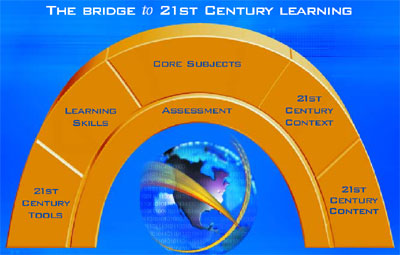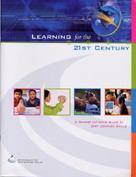Learning for the 21st Century
|
Published by the Partnership for 21st Century Skills July, 2003 |
A Report and Mile Guide for 21st Century Skills
"A simple question to ask is, 'How has the world of a child changed in the last 150 years?" And the answer is, "It's hard to imagine any way in which it hasn't changed! But if you look at school today versus 100 years ago, it is more similar than dissimilar."
— Peter Senge, senior lecturer Massachusetts Institute of Technology
How do we best prepare our young people to succeed in the 21st century? As a comprehensive effort to identify the essential skills that people need today — and tomorrow — the Learning for the 21st Century report articulates a compelling vision for education in the United States and provides an urgent call for action, outlined in its "Mile Guide for 21st Century Skills."
Addressed to "America's education leaders" but also including parents, the business community, researchers, policy makers, community organizations as "stakeholders," the report invites the reader through four carefully crafted sections:
-
Defining the Need for Change takes up Secretary of Education Rod Paige's challenge: "Dream how technology can not only improve education but also transform what we think of as education." It reflects on what kind of education connects to students' real lives as well as how people best learn.
- The Six Key Elements of 21st Century Learning acknowledges the importance of traditional core subjects but expands them with missing elements that make the core subjects relevant to the world in which students live and eventually may work. These six elements form the "Bridge to 21st Century Learning." In this section "Media literacy" is clearly named as one of the higher-order skills that are fundamental to success in the 21st century.
-
Implementing 21st Century Skills: Nine Steps to Build Momentum provides the roadmap for implementing this vision of education both locally and nationally and lists the strategic activities that key stakeholders can do to support the effort.
-
Milestones for Improving Learning and Education (The "Mile Guide") is a unique self-analysis tool to help schools and districts evaluate where they are on the road to being a 21st century learning environments.

The report, designed to "promote a national dialogue about 21st century skills," comes from a unique private/public partnership between major technology companies, the U.S. Department of Education and the National Education Association that in turn consulted with leading U.S. educators, researchers and organizations such as the National School Boards Association, National Coalition for Technology in Education and others.
From the media literacy movement, the Center for Media Literacy along with the Alliance for a Media Literate America (AMLA) and the Just Think Foundation were invited to participate in the Partnership's National Forum on 21st Century Skills in March, 2003. CML's MediaLit Kit™: A Framework for Learning and Teaching in a Media Age is cited several times in the document to substantiate media literacy skills as essential learning skills.
The No Child Left Behind Act of 2001, which reauthorizes the Elementary and Secondary Education Act of 1965, emphasizes student achievement and requires assessments in core subjects, which are the foundation for learning. This reports takes the important next step of outlining a unified and collective vision for education while allowing for innovation and creativity in finding solutions for implementation in districts, schools and classrooms nationwide.
"One key competency that employers across-the-board value in employees is the ability to think creatively and logically in order to solve problems. Such employees are most likely to be promoted in an unforgiving global economy that requires flexibility and an ability to think, speak, and write logically, to solve problems, and to synthedize information."
— The American Diplomacy Project



